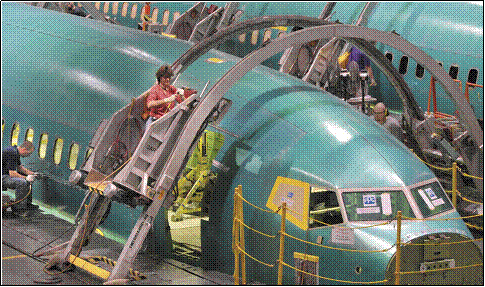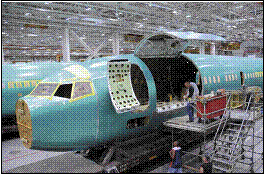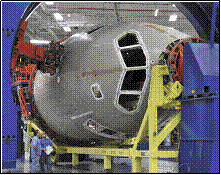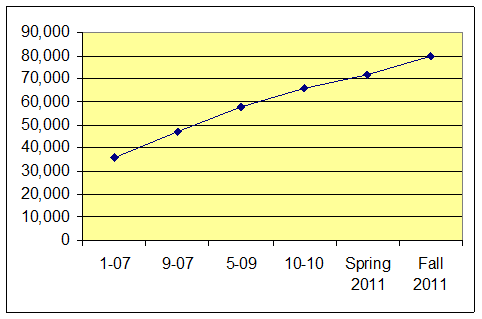DB Schenker/Spirit AeroSystems ― A 4PL Partnership
Wichita, Kansas USA Site Visit
November 17, 2011
By
Richard Armstrong
Attendees:
Jeff Bise, Director Operations – DB Schenker
Steve Turkle, Director SCM – Spirit
Kevin Homan, Operations Manager – DB Schenker
Carey Cargile, Senior Manager – Warehousing – Spirit
Spirit AeroSystems and DB Schenker (DBS) recently signed a 10-year contract extending DBS’ role as fourth-party logistics (4PL) manager for inbound logistics and manufacturing support. The two companies continue to work closely to insure operational efficiencies and continuous improvement. The contract relationship started in August 2006 following Spirit’s spin-off from Boeing in late 2005.
About Spirit¹
Spirit is one of the world’s largest suppliers of commercial airplane assemblies and components. It builds fuselage assemblies and components, propulsion systems and wing components and structures. About 83% of its business is with Boeing but it has expanded to serve Airbus (11%), Sikorsky Helicopter and others. In 2010, it produced fuselages for 3,500 Boeing 737s, 31 Boeing 787s and 23 Boeing 747-8s. For Airbus, it builds the center widebody fuselage piece for the A350 XWB at its new Kinston, North Carolina plant. Spirit also builds wing components for the Airbus A320, A330, A340 and A380.



Spirit’s revenue grew from $3.2 billion in 2006 to $4.2 billion in 2010. It has a $28.3 billion backlog of future business. Spirit was purchased from Boeing by Onex Corporation in 2005. Onex still controls the majority of voting stock.
When Spirit became an independent company in 2005, Steve Turkle and his team led the effort to redesign and improve logistics processes. The main location is and was Wichita. Today, about two-thirds of company employees (10,000) are in Wichita in a complex two miles wide and one mile long covering 600 acres.
Turkle and his team had several major changes to make for the new company. Firstly, they needed to consolidate warehouses and develop into a distribution center model. DBS took the lead and rebuilt a little used manufacturing building at the north end of the campus into a DC. The building makeover took six months and DBS was ready to operate from it in August 2006. Besides the building, DBS built IT capability around the Infor/Exceed WMS (warehouse management system). Also needed were racking and other assets. DBS provided the property and IT improvements. Charges were amortized and paid off as agreed in the original DB Schenker contract.
Labor for the new DC was arranged by DBS for Spirit using Logistics Resources, Inc. (LRI). The new LRI operation grew to 230 employees quickly and remains at that level today absorbing a greater than 30% growth in Spirit’s business.
Turkle also involved DBS in transportation management. Inbound transportation costs were significantly reduced within a year.
Overall, logistics unit costs have been lowered systemically for Spirit and process improvements continue to keep them under control on an ongoing basis.
The Spirit DC averaged 75,000 stock keeping units (SKUs) with 1.5 million pieces of inventory in 2010. A significant part is now consignment inventory.
DB Schenker Logistics’ Role
Working with Carey Cargile, senior warehousing manager for Spirit, DBS Logistics designs and monitors the 250,000 square foot distribution center. It controls the movement of parts from the DC to 600 production locations (work stations) on seven routes within the Spirit manufacturing complex.
DBS Logistics as a 4PL has this – Mission Statement
To continually provide Spirit AeroSystems the logistics tools, technology, and leadership to enable “world class” solutions, delivering important “values” of efficiency, quality, and operational performance, while also providing “sound and significant” returns on investment.
DBS had its transportation management system operational at Spirit’s Wichita location in January 2006. The Spirit distribution center started operations in August 2006 with DBS as the 4PL Manager. In January 2007, 36,000 737 SKUs were brought into inventory. Twin-aisle SKUs (747, 767, 777) were added in September 2007. In May 2009, 787 SKUs were added.
In October 2010, 6,000 aftermarket SKUs were added. In spring 2011, fabricated parts SKUs were added. Managed inventory parts SKUs totaled 80,000 in fall 2011.
SKUs

In June 2011, 25,000 square feet of new warehouse space were added in Plant 1. In November, Warehouse #2 with 125,000 square feet was opened. By year end of 2011, DBS Logistics will manage 400,000 square feet of space and 96% of the vendor production parts for the Wichita campus.
Schenker Logistics has also expanded to Kinston, North Carolina and Saint-Nazaire, France as a third-party logistics provider to support Spirits/Airbus operations.
DBS processes an average of 2,600 orders/45,000 pieces daily between the DC and production sites. Seven routes to 600 locations are serviced by golf carts and tow motors pulling carts and wagons loaded with Kan-bans and kits.


Small parts are kitted and several thousand special kits have been made. The kits have foam interiors cut to size to accommodate each part.

The kits are transported to specific sites where they are usually off loaded to specific free standing rack locations.


Longer pieces are racked separately and are warehoused using a bank of tubes. Long, straight pieces are stored by SKU, tube by tube.

Parts are called to assembly control locations as needed by Spirit warehouse employees using an electronic handheld device which feeds information to the Infor/Exceed WMS – matching to master schedule orders received by Spirit’s SAP.

This Visual Lineside Management (VLM) allows for parts to arrive on an as needed basis and shrinks unnecessary inventory at each assembly control center. The implementation of VLM has reduced backorders by 79% and work in process by 72%. Estimated yearly savings are over $600,000.
Back in the warehouse every picking and kitting location has its own scoreboard. These scoreboards alert employees and managers to production levels.

Spirit and DBS regularly cooperate on Kaizen events to increase efficiency and reduce cost. An example is the Receiving Consolidation/Re-Engineering Kaizen completed late in 2010. Carey Cargile of Spirit and Kevin Homan of Schenker were key participants along with LRI personnel and Spirit’s receiving departments.
The goals of this Kaizen were:
- CREATE space to accommodate future or “new” processes coming to the Spirit DC.
- CONSOLIDATE the redundant receiving operations to reduce space and provide process/labor flexibility.
- ILLUSTRATE “Best in Class” technology solutions as “Real Time” KPI (key performance indicator) information is displayed at work stations for employees and supervisors to monitor performance through “status at a glance”.
- POTENTIALLY decrease man-hours/day.
Results achieved were:
- A redesign and simplification of three receiving areas into one.
- A freeing up of floor space by moving China boxes outside.
- Moving fixtures and data lines to new locations.
- Improve the ASN (advanced shipping notice) on dock process to achieve better precision.
- Receiving dashboards were installed at four stations.
- Cross-dock boards were relocated.
The Receiving Consolidation/Re-Engineering Kaizen at the Wichita Spirit DC is illustrative of the ongoing cooperation and partnership between DBS and Spirit. As Steve Turkle points out, “Logistics brings the solution to the manufacturing floor.”
With the kind of solutions and results DB Schenker Logistics has brought to Spirit, it’s not surprising that it has a new 10-year contract.
________________________
¹Spririt AeroSystems, Inc. Annual Report – 2010
Sources: A&A Primary Research, http://www.dbschenker.com/


